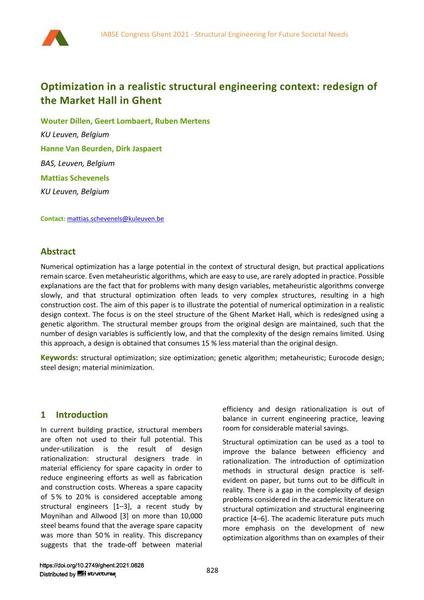Optimization in a realistic structural engineering context: redesign of the Market Hall in Ghent

|
|
|||||||||||
Bibliografische Angaben
| Autor(en): |
Wouter Dillen
(KU Leuven, Belgium)
Geert Lombaert Ruben Mertens (KU Leuven, Belgium) Hanne Van Beurden (BAS, Leuven, Belgium Mattias Schevenels KU Leuven, Belgium) Dirk Jaspaert (BAS, Leuven, Belgium Mattias Schevenels KU Leuven, Belgium) |
||||
|---|---|---|---|---|---|
| Medium: | Tagungsbeitrag | ||||
| Sprache(n): | Englisch | ||||
| Tagung: | IABSE Congress: Structural Engineering for Future Societal Needs, Ghent, Belgium, 22-24 September 2021 | ||||
| Veröffentlicht in: | IABSE Congress Ghent 2021 | ||||
|
|||||
| Seite(n): | 828-835 | ||||
| Anzahl der Seiten (im PDF): | 8 | ||||
| DOI: | 10.2749/ghent.2021.0828 | ||||
| Abstrakt: |
Numerical optimization has a large potential in the context of structural design, but practical applications remain scarce. Even metaheuristic algorithms, which are easy to use, are rarely adopted in practice. Possible explanations are the fact that for problems with many design variables, metaheuristic algorithms converge slowly, and that structural optimization often leads to very complex structures, resulting in a high construction cost. The aim of this paper is to illustrate the potential of numerical optimization in a realistic design context. The focus is on the steel structure of the Ghent Market Hall, which is redesigned using a genetic algorithm. The structural member groups from the original design are maintained, such that the number of design variables is sufficiently low, and that the complexity of the design remains limited. Using this approach, a design is obtained that consumes 15 % less material than the original design. |
||||
| Stichwörter: |
Tragwerksoptimierung
|
||||
| Copyright: | © 2021 International Association for Bridge and Structural Engineering (IABSE) | ||||
| Lizenz: | Die Urheberrechte (Copyright) für dieses Werk sind rechtlich geschützt. Es darf nicht ohne die Zustimmung des Autors/der Autorin oder Rechteinhabers/-in weiter benutzt werden. |
||||
